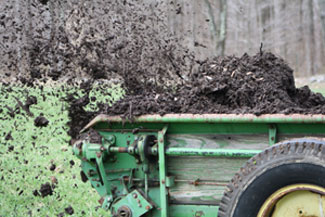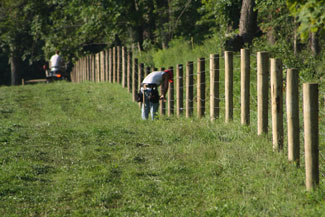
 |
|
“For the first time in the history of human institutions, the Benedictine abbey created a way of life in which practical and theoretical skills could be embodied in the same person. This new atmosphere proved of enormous importance for the development of European technology and science. The Benedictine abbeys did not immediately launch into scientific investigations, but by encouraging the
combination of physical and intellectual work they destroyed the old artificial barrier between the empirical and the speculative, the manual and the liberal arts. This
created an atmosphere favorable for the development of
knowledge based on experimentation.
”
René Dubos (A God Within) |

OUR BENEDICTINE APPROACH The degree of reverence for creation mandated by St. Benedict  sets a standard that has made Benedictines environmentally conscientious from the beginning of their history. The injunction in the Rule to treat the property of the monastery as “sacred vessels of the altar,” suggests that everything in creation is potentially capable of mediating union with God. Some areas of the abbey land are especially designated as Environmental-Historical Preserve, which means they are reserved as part of the monastic enclosure, but also that they hold significant historical landmarks or fragile environments, such as wetlands or wildlife habitats that need to be protected. The late conservationist René Dubos wrote that St. Benedict should be considered as a patron saint of those who believe that conservation and preservation means developing human activities that create sustainable relationships between human and nonhuman life. sets a standard that has made Benedictines environmentally conscientious from the beginning of their history. The injunction in the Rule to treat the property of the monastery as “sacred vessels of the altar,” suggests that everything in creation is potentially capable of mediating union with God. Some areas of the abbey land are especially designated as Environmental-Historical Preserve, which means they are reserved as part of the monastic enclosure, but also that they hold significant historical landmarks or fragile environments, such as wetlands or wildlife habitats that need to be protected. The late conservationist René Dubos wrote that St. Benedict should be considered as a patron saint of those who believe that conservation and preservation means developing human activities that create sustainable relationships between human and nonhuman life. STABILITY AND SUSTAINABILITY  Through the Benedictine vow of stability, the Regina Laudis community is committed to the sustainability not only of our monastic life and land, but we strive to consider all aspects of the environment as interdependent and so to relate our agricultural efforts within the broader ecological and cultural fabric of our neighbors and the region. Areas of particular ecological concern include forest management, erosion control, recycling and composting, waste management, and water quality initiatives. Since 1993 we have been working with local, state and federal agencies to protect and enhance the abundant wetland and aquatic environments on the property of the monastery.
Through the Benedictine vow of stability, the Regina Laudis community is committed to the sustainability not only of our monastic life and land, but we strive to consider all aspects of the environment as interdependent and so to relate our agricultural efforts within the broader ecological and cultural fabric of our neighbors and the region. Areas of particular ecological concern include forest management, erosion control, recycling and composting, waste management, and water quality initiatives. Since 1993 we have been working with local, state and federal agencies to protect and enhance the abundant wetland and aquatic environments on the property of the monastery. ENVIRONMENTAL INITIATIVES  With the grants from the Natural Resources Conservation Program (NRCS), the Environmental Quality Incentives Program (EQUIP) grant and a government River Restoration Grant, we have been able to improve pasture access over sensitive wetland areas by installing hi-tensile, electric fencing, allowing more intensive rotational grazing. We have also installed a composting facility, named Lazarus which has eliminated leaching problems and enabled us to improve the soil quality of our gardens. With the grants from the Natural Resources Conservation Program (NRCS), the Environmental Quality Incentives Program (EQUIP) grant and a government River Restoration Grant, we have been able to improve pasture access over sensitive wetland areas by installing hi-tensile, electric fencing, allowing more intensive rotational grazing. We have also installed a composting facility, named Lazarus which has eliminated leaching problems and enabled us to improve the soil quality of our gardens.A CHEESEMAKER'S EXPERIENCE OF COMPOSTING Both composting and cheesemaking are about the cultivation and nurturing of life on the microscopic level. In the Abbey's compost facility, Lazarus,
 the organic waste from the sheep barn and the Abbey kitchens is transformed into compost—the very elixir of life to our gardens. Both cheesemaking and composting are about transformation of one substance into another over time. In the process of making cheese liquid milk is changed into solid curd and curd into a refined cheese. In composting, unwanted organic waste is changed into the coveted life blood of the garden. In both cases the radical transformation that occurs is brought about largely with the help of billions of microscopic organisms. the organic waste from the sheep barn and the Abbey kitchens is transformed into compost—the very elixir of life to our gardens. Both cheesemaking and composting are about transformation of one substance into another over time. In the process of making cheese liquid milk is changed into solid curd and curd into a refined cheese. In composting, unwanted organic waste is changed into the coveted life blood of the garden. In both cases the radical transformation that occurs is brought about largely with the help of billions of microscopic organisms.Oblate Brother David Aeschliman |
||
| Copyright © 2013 Abbey of Regina Laudis. All rights reserved. | |||